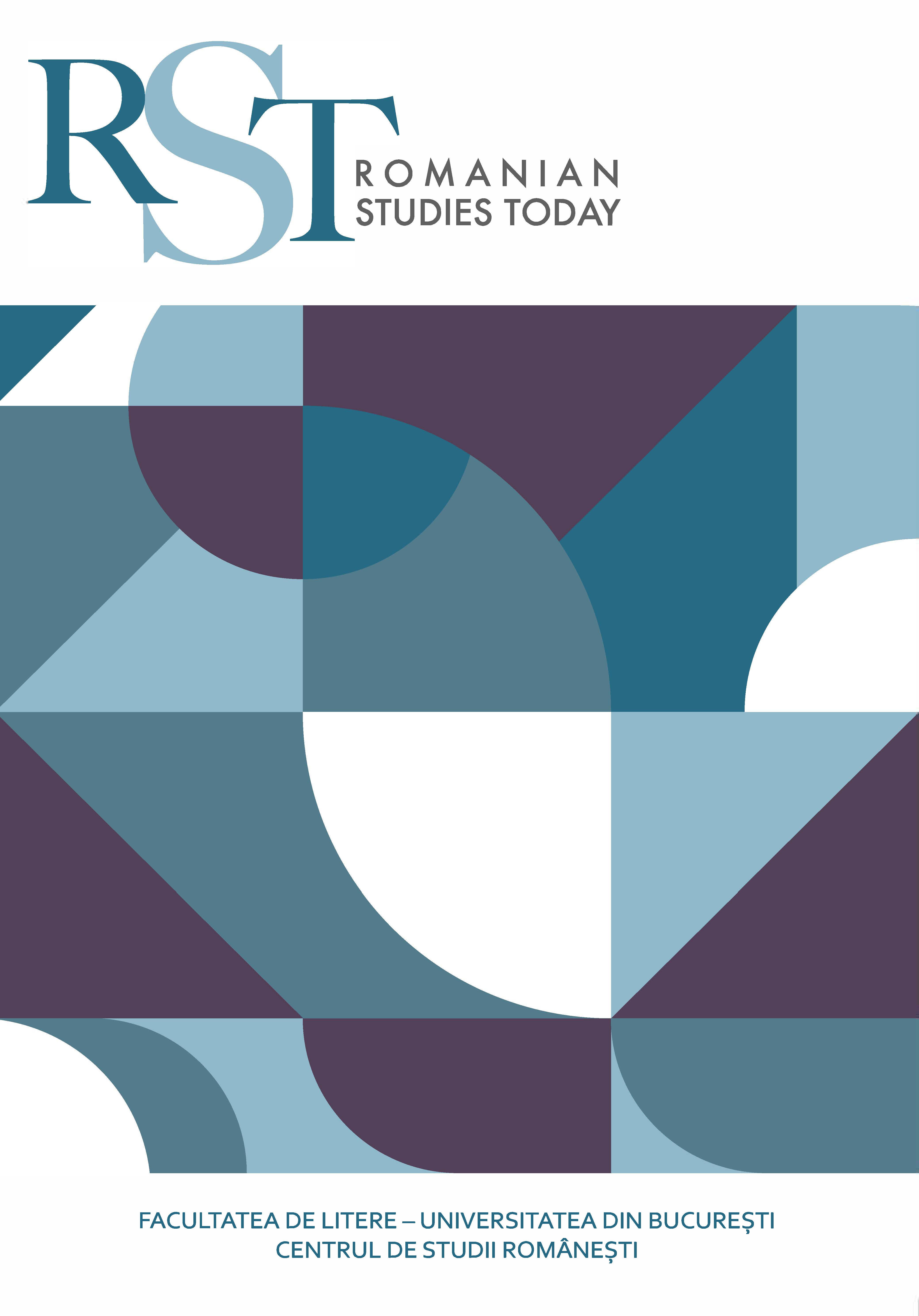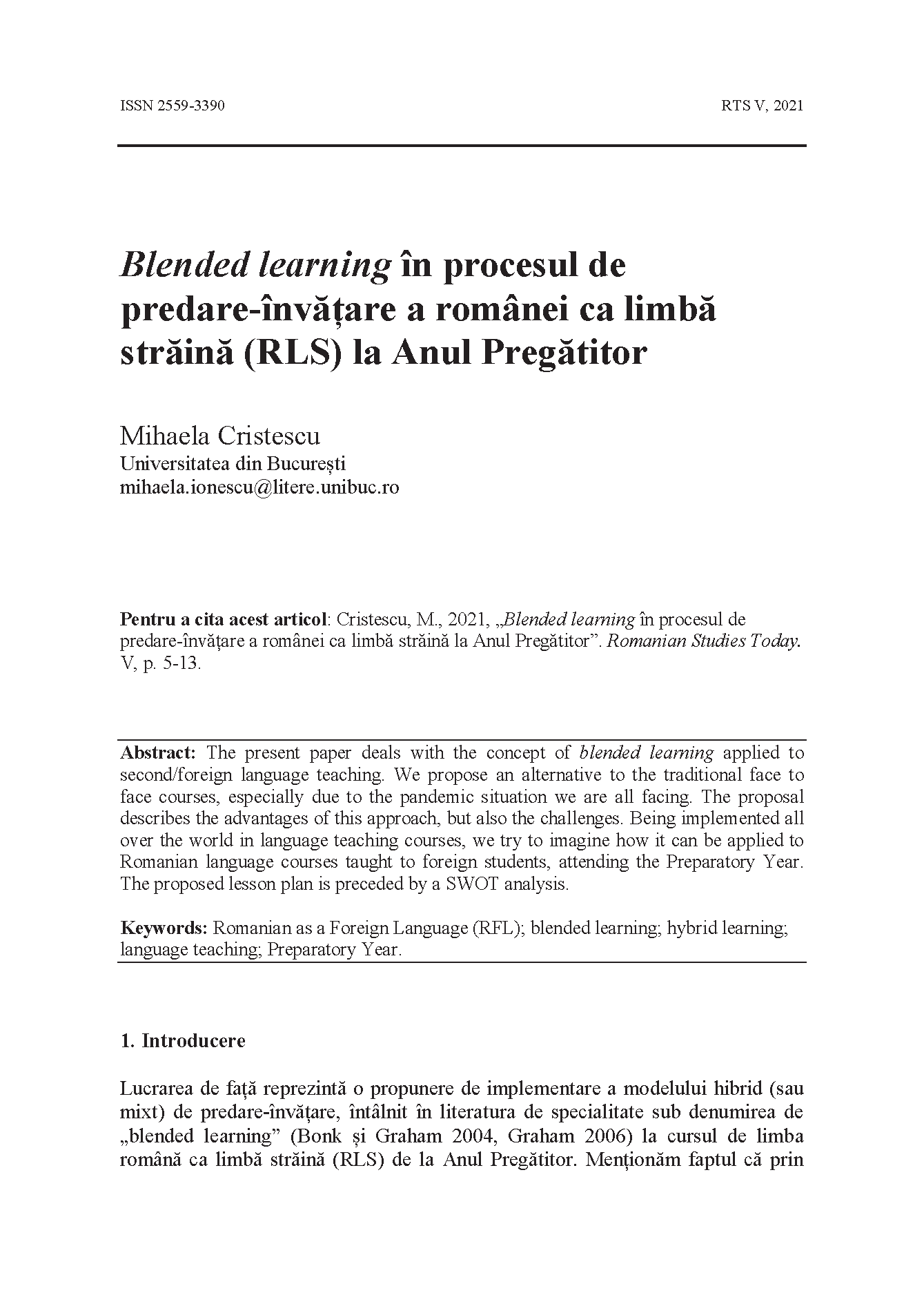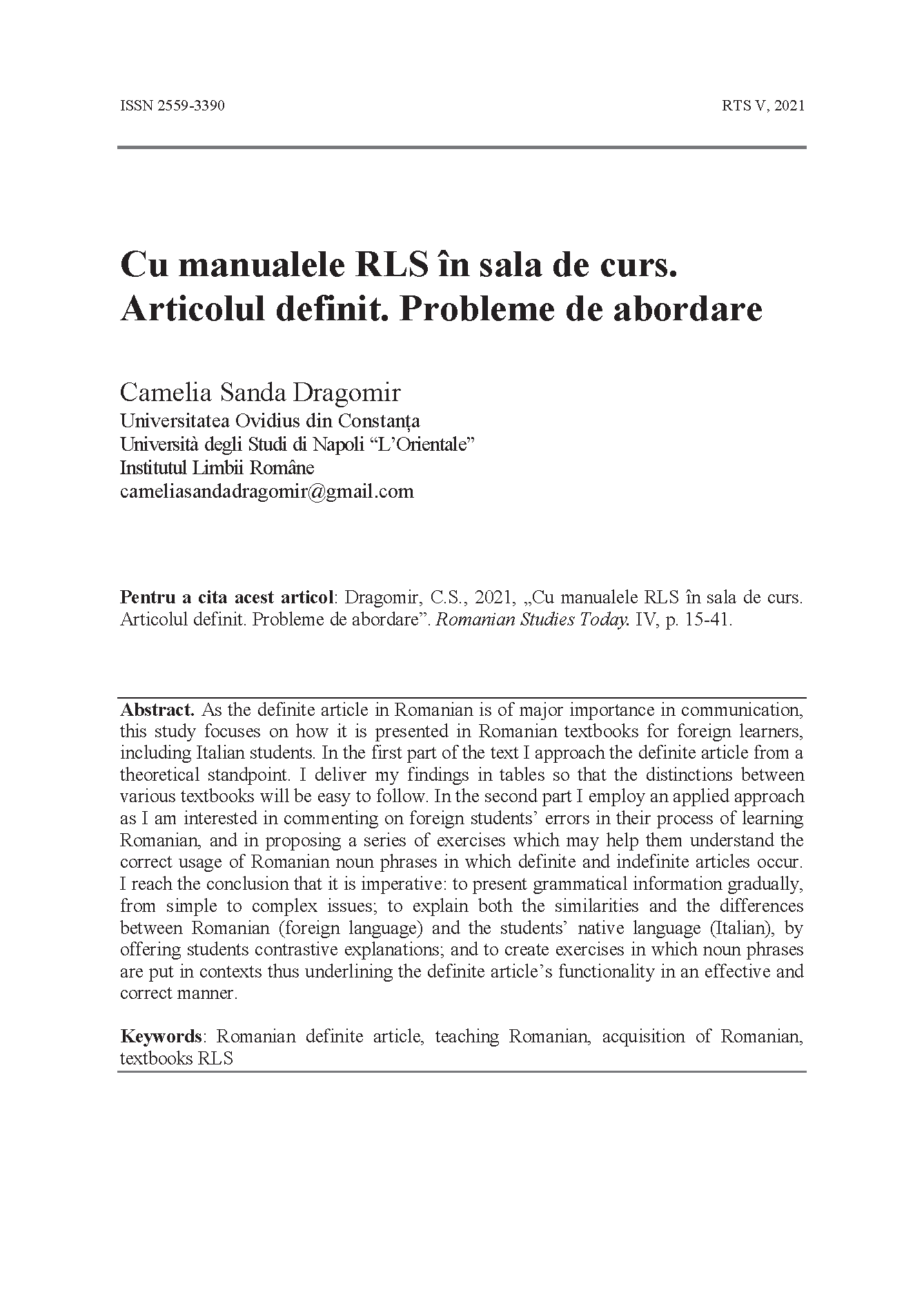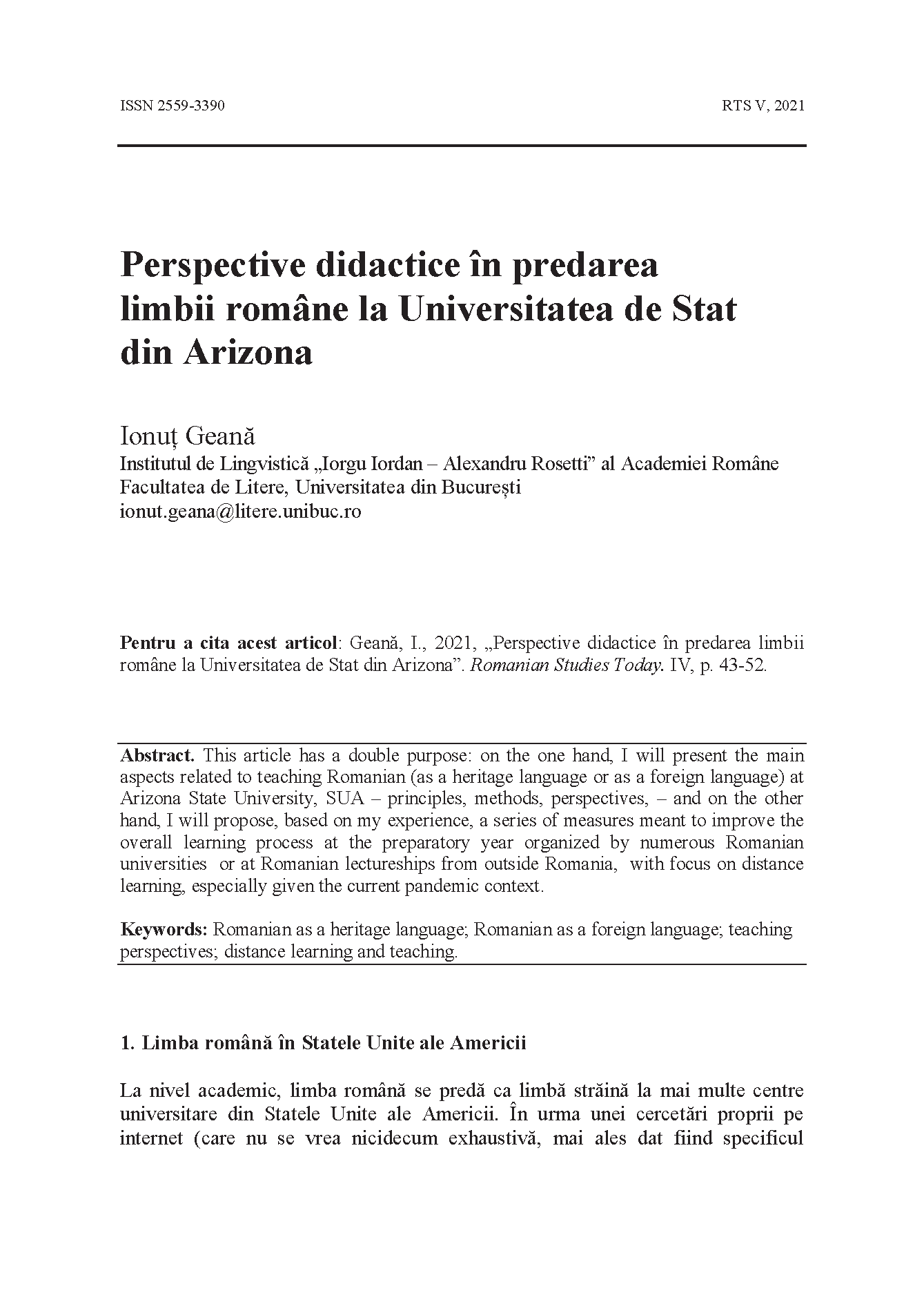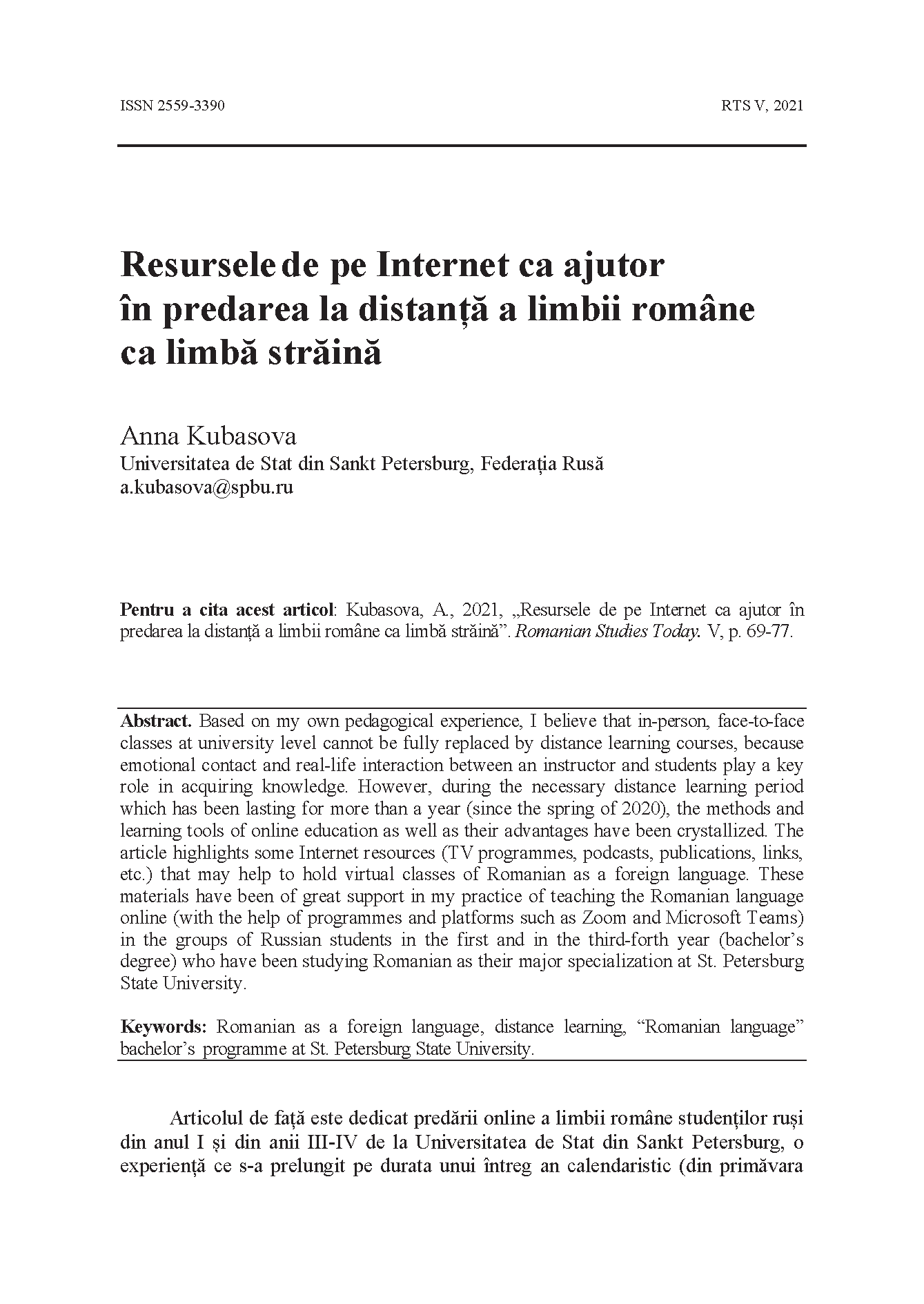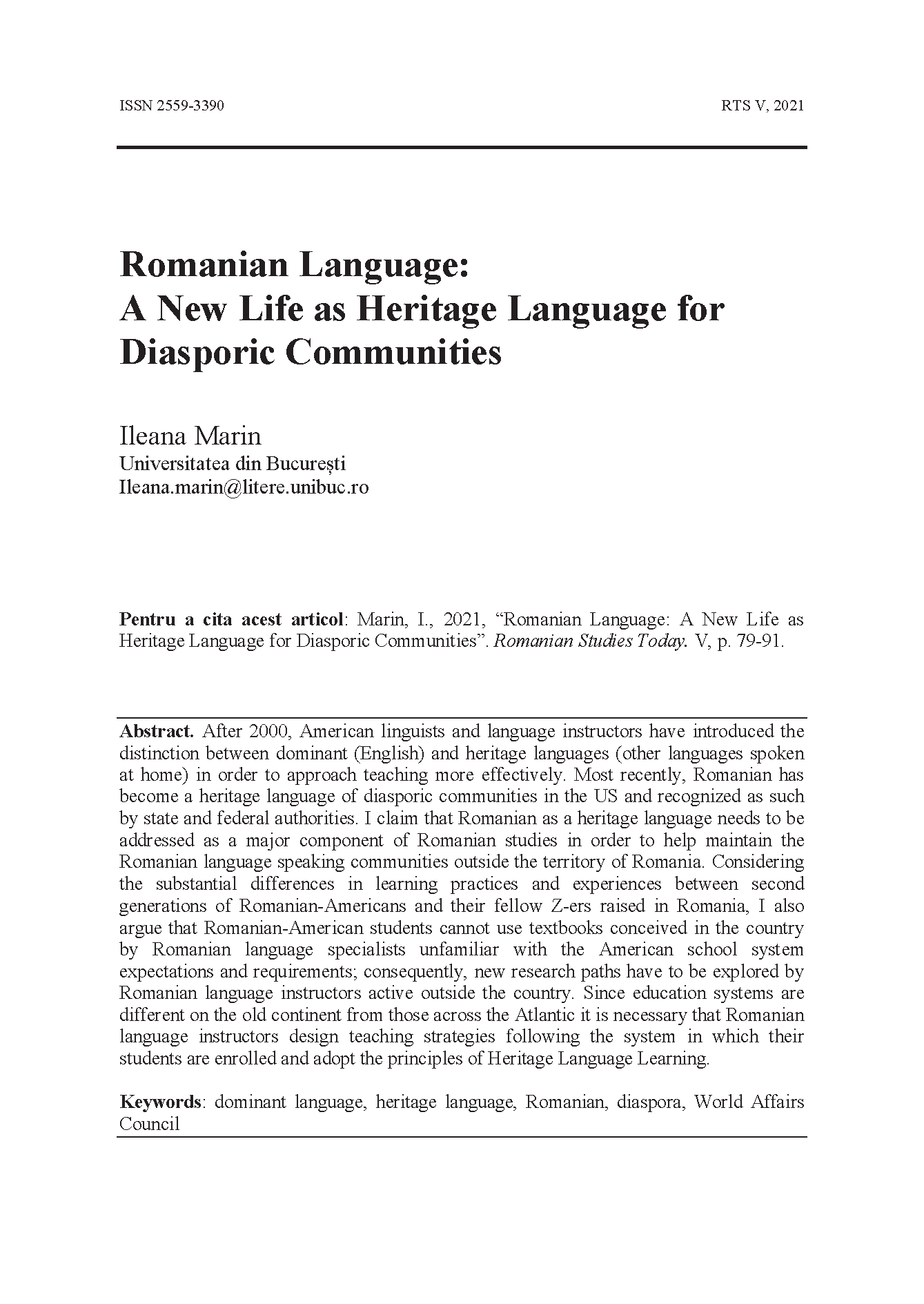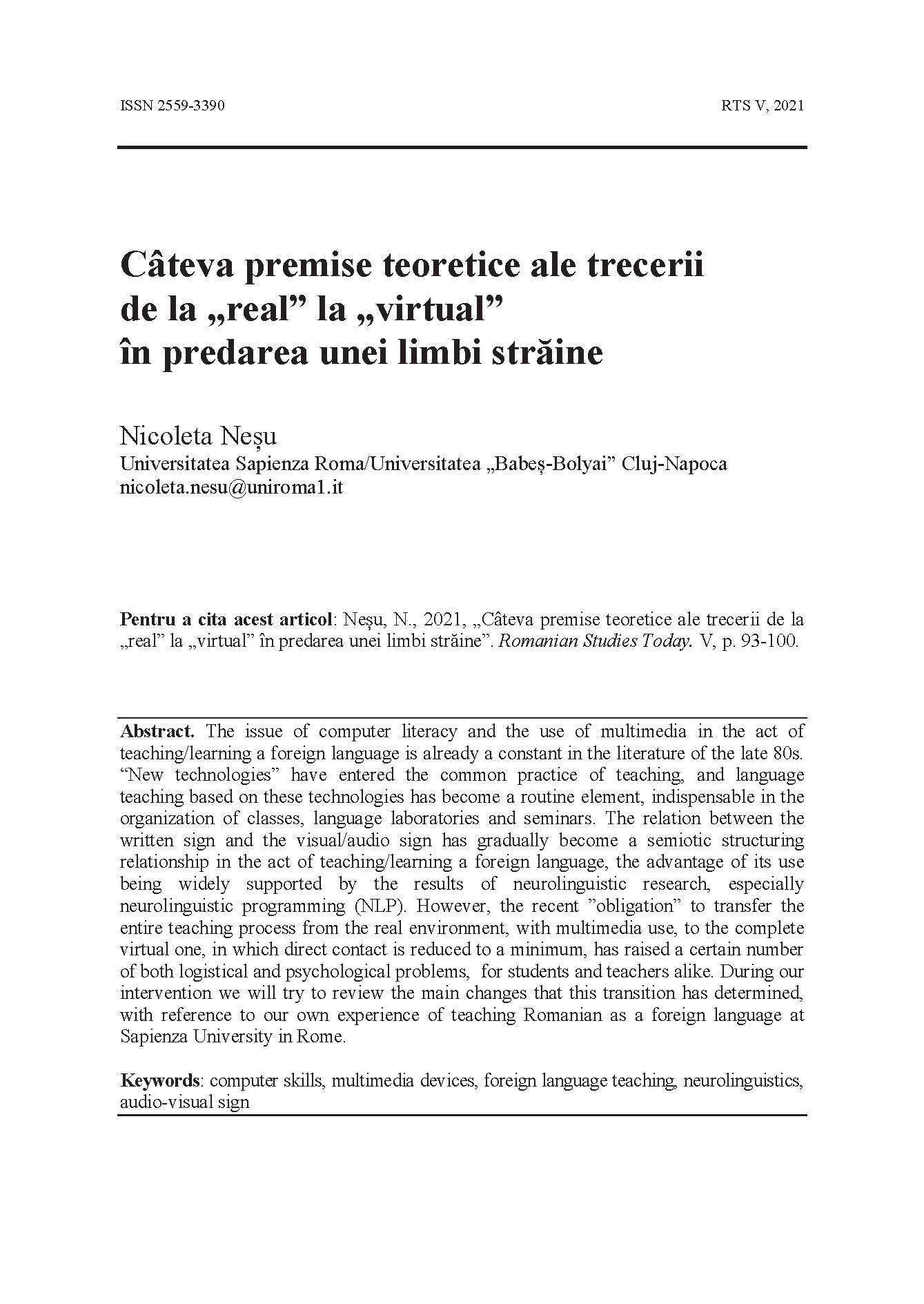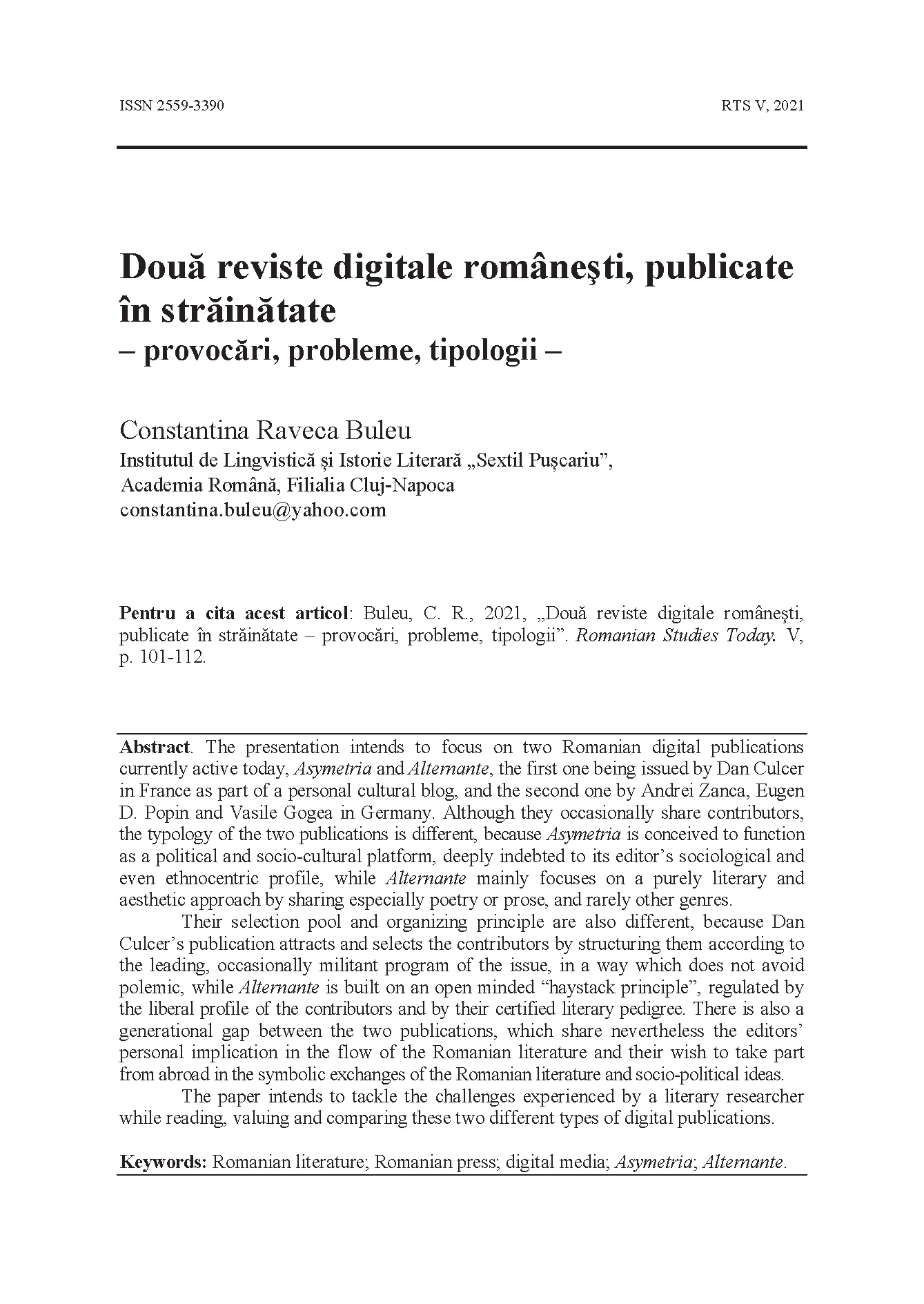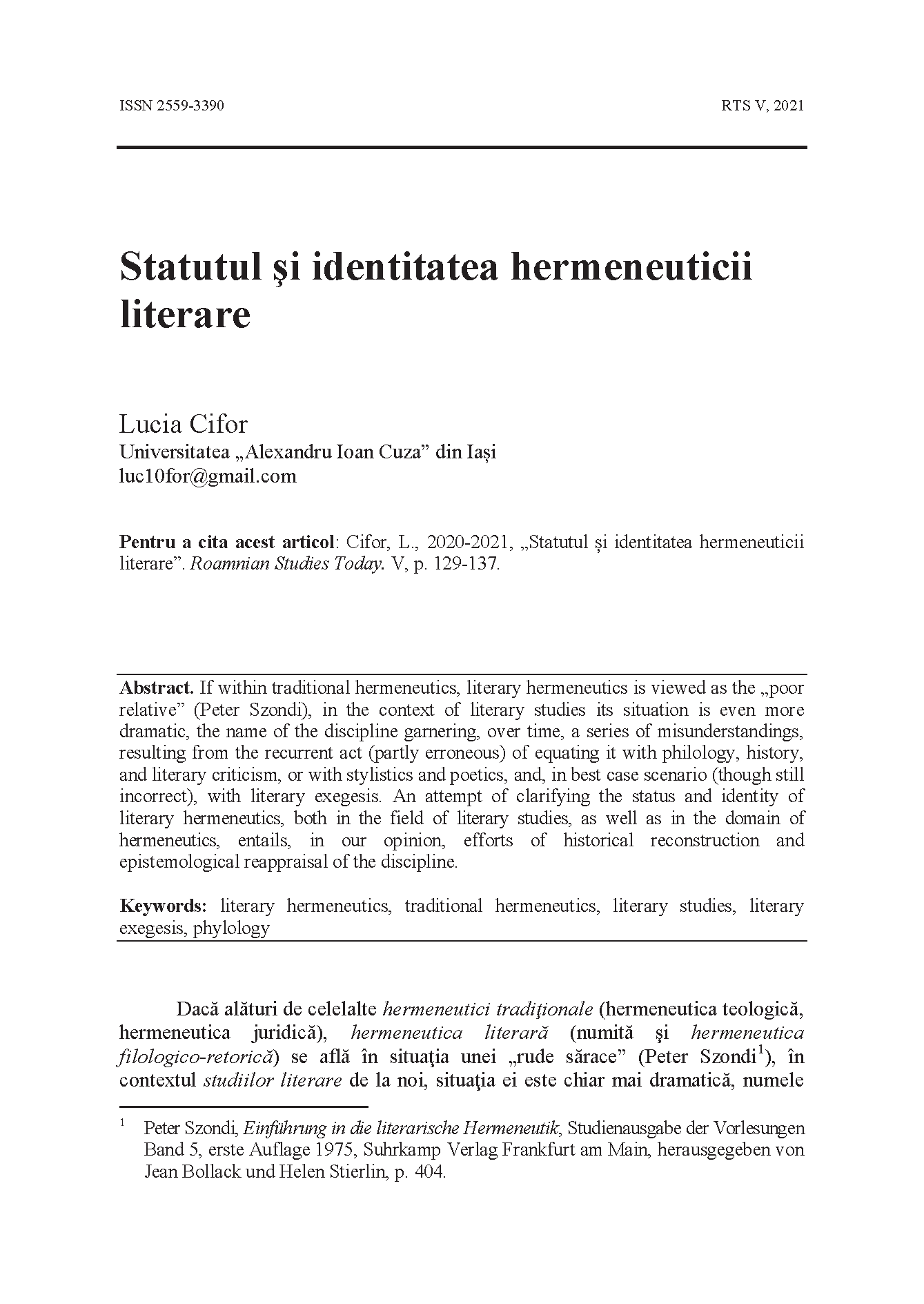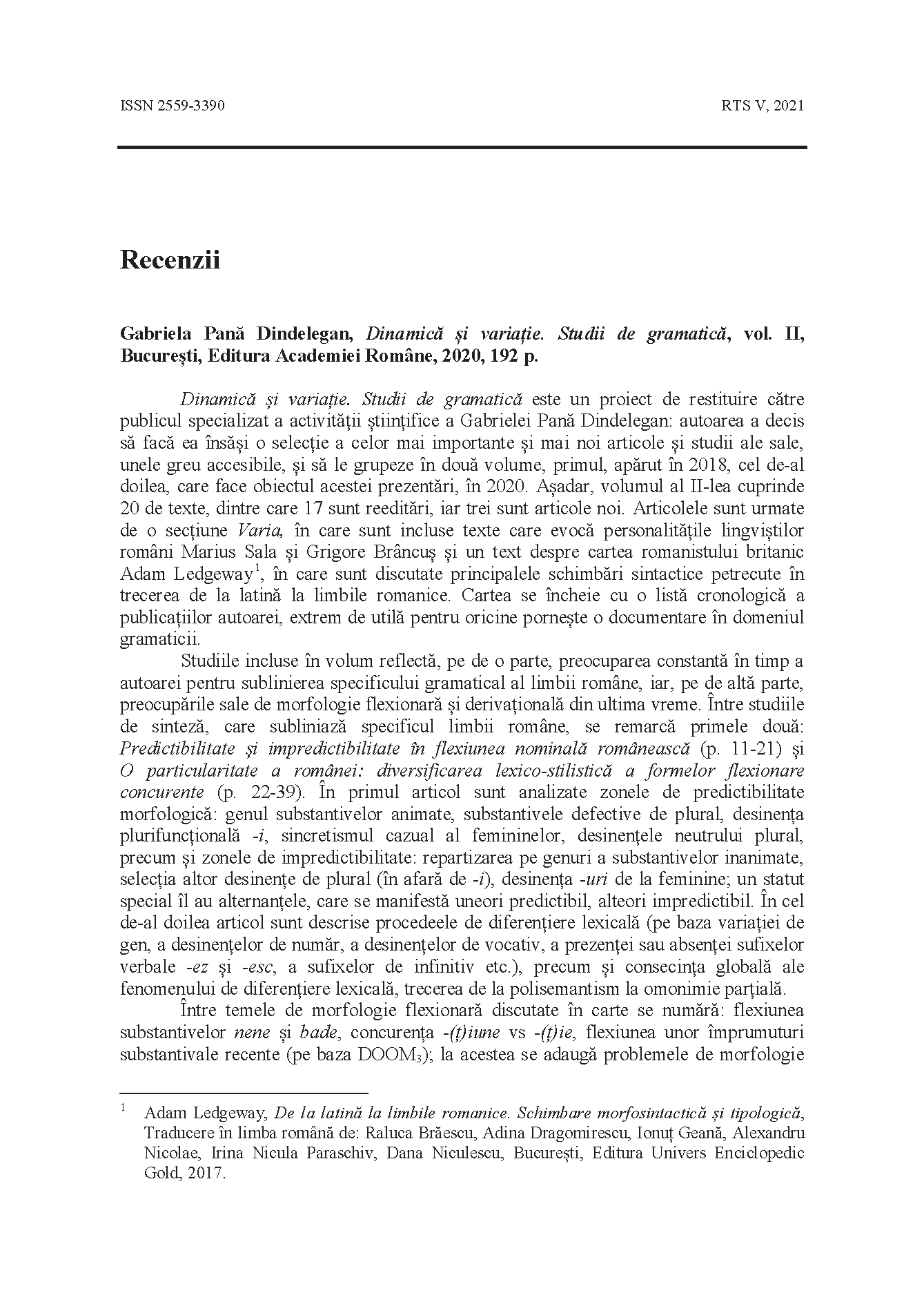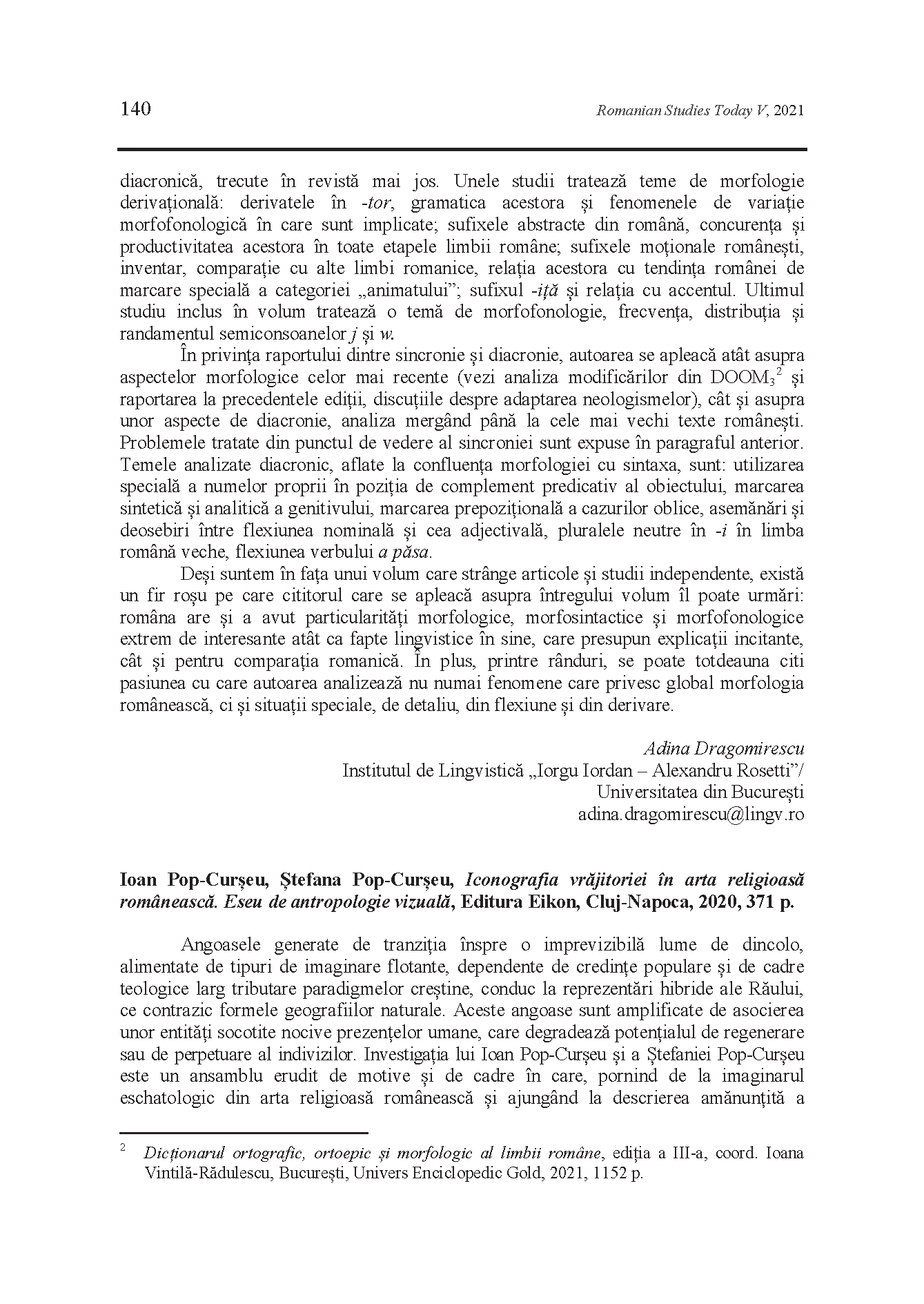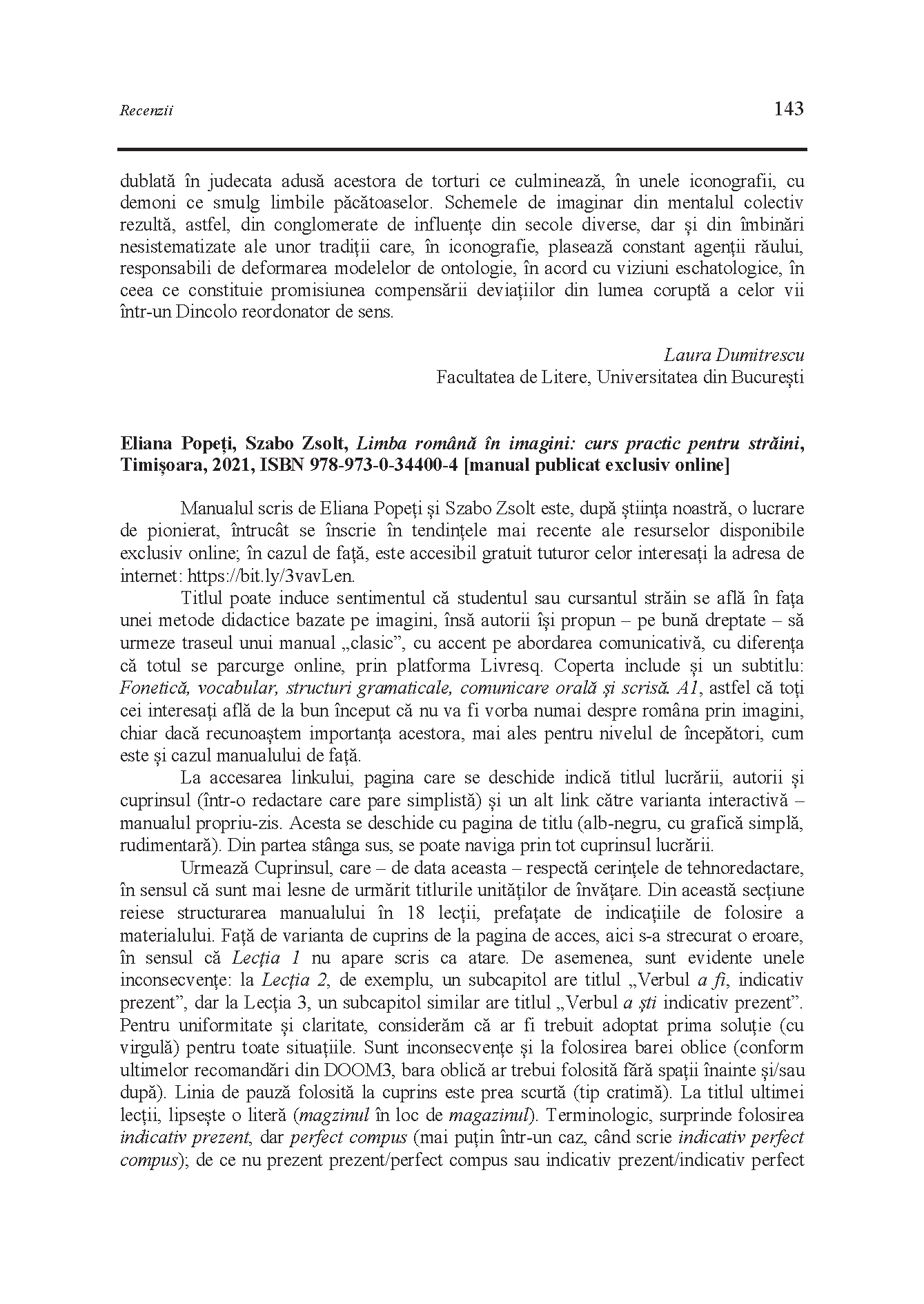Volum 5 Nr. 5 (2021): ROMANIAN STUDIES TODAY V, 2021

Principalele sale axe de interes: poziționarea studiilor românești ca parte integrantă a disciplinelor socio-umaniste contemporane, problematici ale procesului de învățare a limbii române ca limbă străină. Romanian Studies Today se adresează româniștilor din universități și institute de cercetare, dar și specialiștilor în studii regionale, istorie, antropologie, studii politice sau cercetătorilor din alte discipline care sunt interesați de limba și cultura română.
Număr complet
Articles
-
Blended learning în procesul de predare-învăţare a românei ca limbă străină (RLS) la Anul Pregătitor
Rezumat
The present paper deals with the concept of blended learning applied to second/foreign language teaching. We propose an alternative to the traditional face to face courses, especially due to the pandemic situation we are all facing. The proposal describes the advantages of this approach, but also the challenges. Being implemented all over the world in language teaching courses, we try to imagine how it can be applied to Romanian language courses taught to foreign students, attending the Preparatory Year. The proposed lesson plan is preceded by a SWOT analysis.
-
Cu manualele RLS în sala de curs. Articolul definit. Probleme de abordare
Rezumat
As the definite article in Romanian is of major importance in communication, this study focuses on how it is presented in Romanian textbooks for foreign learners, including Italian students. In the first part of the text I approach the definite article from a theoretical standpoint. I deliver my findings in tables so that the distinctions between various textbooks will be easy to follow. In the second part I employ an applied approach as I am interested in commenting on foreign students’ errors in their process of learning Romanian, and in proposing a series of exercises which may help them understand the correct usage of Romanian noun phrases in which definite and indefinite articles occur.
I reach the conclusion that it is imperative: to present grammatical information gradually, from simple to complex issues; to explain both the similarities and the differences between Romanian (foreign language) and the students’ native language (Italian), by offering students contrastive explanations; and to create exercises in which noun phrases
are put in contexts thus underlining the definite article’s functionality in an effective and correct manner. -
Perspective didactice în predarea limbii române la Universitatea de Stat din Arizona
Rezumat
This article has a double purpose: on the one hand, I will present the main aspects related to teaching Romanian (as a heritage language or as a foreign language) at Arizona State University, SUA – principles, methods, perspectives, – and on the other hand, I will propose, based on my experience, a series of measures meant to improve the overall learning process at the preparatory year organized by numerous Romanian universities or at Romanian lectureships from outside Romania, with focus on distance learning, especially given the current pandemic context.
-
Evaluarea în era digitală la Anul pregătitor. Platforma Exam.net, un instrument util în evaluarea de la cursurile de română ca limbă străină
Rezumat
The aim of this paper is to describe the process of evaluation which occurs in a digital environment using Exam.net, an examination platform developed by a group of Swedish teachers. The mechanism behind Exam.net was analysed during the numerous evaluation activities which took place in May and June 2020, as a part of the second semester examination at the Preparatory Year of Romanian (a full-time academic programme organised by the University of Bucharest). Based on the cloud-computing system, Exam.net is an easy-to-use and secure evaluation tool, with several technical and didactic advantages, which are explained in the present paper. The platform was created in accordance with the requirements set out by the National Agency for Education in Sweden regarding data handling and anonymisation. Nevertheless, the main advantage of Exam.net consists in the two different levels of security: the low-security mode and the high-security mode, the latter being associated with Safe Exam Browser (SEB), a type of software which prevents unauthorized resources being used during an exam. As a result, both layers of security considerably reduce the risk of examination fraud. In addition to this, Exam.net is highly reliable, given its infrastructure that automatically handles a large number of concurrent users.
-
Resursele de pe Internet ca ajutor în predarea la distanţă a limbii române ca limbă străină
Rezumat
Based on my own pedagogical experience, I believe that in-person, face-to-face classes at university level cannot be fully replaced by distance learning courses, because emotional contact and real-life interaction between an instructor and students play a key role in acquiring knowledge. However, during the necessary distance learning period which has been lasting for more than a year (since the spring of 2020), the methods and learning tools of online education as well as their advantages have been crystallized. The article highlights some Internet resources (TV programmes, podcasts, publications, links, etc.) that may help to hold virtual classes of Romanian as a foreign language. These materials have been of great support in my practice of teaching the Romanian language online (with the help of programmes and platforms such as Zoom and Microsoft Teams) in the groups of Russian students in the first and in the third-forth year (bachelor's degree) who have been studying Romanian as their major specialization at St. Petersburg State University.
-
Romanian Language: A New Life as Heritage Language for Diasporic Communities
Rezumat
After 2000, American linguists and language instructors have introduced the distinction between dominant (English) and heritage languages (other languages spoken at home) in order to approach teaching more effectively. Most recently, Romanian has become a heritage language of diasporic communities in the US and recognized as such
by state and federal authorities. I claim that Romanian as a heritage language needs to be addressed as a major component of Romanian studies in order to help maintain the Romanian language speaking communities outside the territory of Romania. Considering the substantial differences in learning practices and experiences between second
generations of Romanian-Americans and their fellow Z-ers raised in Romania, I also argue that Romanian-American students cannot use textbooks conceived in the country by Romanian language specialists unfamiliar with the American school system expectations and requirements; consequently, new research paths have to be explored by
Romanian language instructors active outside the country. Since education systems are different on the old continent from those across the Atlantic it is necessary that Romanian language instructors design teaching strategies following the system in which their students are enrolled and adopt the principles of Heritage Language Learning. -
Câteva premise teoretice ale trecerii de la „real” la „virtual” în predarea unei limbi străine
Rezumat
The issue of computer literacy and the use of multimedia in the act of teaching/learning a foreign language is already a constant in the literature of the late 80s. “New technologies” have entered the common practice of teaching, and language teaching based on these technologies has become a routine element, indispensable in the organization of classes, language laboratories and seminars. The relation between the written sign and the visual/audio sign has gradually become a semiotic structuring relationship in the act of teaching/learning a foreign language, the advantage of its use being widely supported by the results of neurolinguistic research, especially neurolinguistic programming (NLP). However, the recent ”obligation” to transfer the entire teaching process from the real environment, with multimedia use, to the complete virtual one, in which direct contact is reduced to a minimum, has raised a certain number of both logistical and psychological problems, for students and teachers alike. During our intervention we will try to review the main changes that this transition has determined, with reference to our own experience of teaching Romanian as a foreign language at Sapienza University in Rome.
-
Două reviste digitale româneşti, publicate în străinătate provocări, probleme, tipologii
Rezumat
The presentation intends to focus on two Romanian digital publications currently active today, Asymetria and Alternante, the first one being issued by Dan Culcer in France as part of a personal cultural blog, and the second one by Andrei Zanca, Eugen
- Popin and Vasile Gogea in Germany. Although they occasionally share contributors, the typology of the two publications is different, because Asymetria is conceived to function as a political and socio-cultural platform, deeply indebted to its editor's sociological and even ethnocentric profile, while Alternante mainly focuses on a purely literary and aesthetic approach by sharing especially poetry or prose, and rarely other genres.
Their selection pool and organizing principle are also different, because Dan Culcer's publication attracts and selects the contributors by structuring them according to the leading, occasionally militant program of the issue, in a way which does not avoid polemic, while Alternante is built on an open minded "haystack principle", regulated by the liberal profile of the contributors and by their certified literary pedigree. There is also a generational gap between the two publications, which share nevertheless the editors' personal implication in the flow of the Romanian literature and their wish to take part from abroad in the symbolic exchanges of the Romanian literature and socio-political ideas.
The paper intends to tackle the challenges experienced by a literary researcher while reading, valuing and comparing these two different types of digital publications.
-
Basil Munteanu, un istoric literar aproape uitat
Rezumat
This essay is focused on a Historian of Literary History, Basil Munteanu, and his masterwork, The Panorama of Romanian Literature, who initially has been written in French and published at a French Publishing House, and translated to five different Western Languages, being more famous abroad than in his own country. I have been
studied both his literary biography and his works, trying to comprehend the way in which a History of Romanian Literature, written for a Foreign receptor will differ from a Romanian History of Romanian Literature, for example those written by G. Călinescu, The History of Romanian Literature, from Its Beginnings to the Present Days. -
Statutul şi identitatea hermeneuticii literare
Rezumat
If within traditional hermeneutics, literary hermeneutics is viewed as the „poor relative" (Peter Szondi), in the context of literary studies its situation is even more dramatic, the name of the discipline garnering, over time, a series of misunderstandings, resulting from the recurrent act (partly erroneous) of equating it with philology, history, and literary criticism, or with stylistics and poetics, and, in best case scenario (though still incorrect), with literary exegesis. An attempt of clarifying the status and identity of literary hermeneutics, both in the field of literary studies, as well as in the domain of hermeneutics, entails, in our opinion, efforts of historical reconstruction and epistemological reappraisal of the discipline.
Book Reviews
-
Gabriela Pană Dindelegan, Dinamică şi variaţie. Studii de gramatică, vol. II, Bucureşti, Editura Academiei Române, 2020, 192 p.
Rezumat
Dinamică şi variaţie. Studii de gramatică este un proiect de restituire către publicul specializat a activităţii ştiinţifice a Gabrielei Pană Dindelegan: autoarea a decis să facă ea însăşi o selecţie a celor mai importante şi mai noi articole şi studii ale sale, unele greu accesibile, şi să le grupeze în două volume, primul, apărut în 2018, cel de-al doilea, care face obiectul acestei prezentări, în 2020. Aşadar, volumul al II-lea cuprinde 20 de texte, dintre care 17 sunt reeditări, iar trei sunt articole noi. Articolele sunt urmate de o secţiune Varia, în care sunt incluse texte care evocă personalităţile lingviştilor români Marius Sala şi Grigore Brâncuş şi un text despre cartea romanistului britanic Adam Ledgeway1, în care sunt discutate principalele schimbări sintactice petrecute în trecerea de la latină la limbile romanice. Cartea se încheie cu o listă cronologică a publicaţiilor autoarei, extrem de utilă pentru oricine porneşte o documentare în domeniul gramaticii.
-
Ioan Pop-Curşeu, Ştefana Pop-Curşeu, lconografia vrăjitoriei în arta religioasă românească. Eseu de antropologie vizuală, Editura Eikon, Cluj-Napoca, 2020, 371 p.
Rezumat
Angoasele generate de tranziţia înspre o imprevizibilă lume de dincolo, alimentate de tipuri de imaginare flotante, dependente de credinţe populare şi de cadre teologice larg tributare paradigmelor creştine, conduc la reprezentări hibride ale Răului, ce contrazic formele geografiilor naturale. Aceste angoase sunt amplificate de asocierea unor entităţi socotite nocive prezenţelor umane, care degradează potenţialul de regenerare sau de perpetuare al indivizilor. Investigaţia lui Ioan Pop-Curşeu şi a Ştefaniei Pop-Curşeu este un ansamblu erudit de motive şi de cadre în care, pornind de la imaginarul eschatologic din arta religioasă românească şi ajungând la descrierea amănunţită a
tipologiilor atât lingvistice, precum şi a celor iconografice asociate vrăjitoarelor, autorii urmăresc variaţiuni într-un tablou al grotescului feminin, cu grade potenţiale de toxicitate şi de corupere morală: de la fantasme ale demonologilor din spaţiul culturii occidentale, cu extreme vizuale în copulaţii satanice şi anomalii de desfrânare, până la imaginea „luătoarelor de mană cu şuştarul pe cap" şi a „fermecătoarelor bătute de diavol", toate apar ca deviaţii ale modelului de feminitate fertilă sau menită să resusciteze creaţia în lume.
-
Eliana Popeţi, Szabo Zsolt, Limba română în imagini: curs practic pentru străini, Timişoara, 2021, ISBN 978-973-0-34400-4 [manual publicat exclusiv online]
Rezumat
Manualul scris de Eliana Popeţi şi Szabo Zsolt este, după ştiinţa noastră, o lucrare de pionierat, întrucât se înscrie în tendinţele mai recente ale resurselor disponibile exclusiv online; în cazul de faţă, este accesibil gratuit tuturor celor interesaţi la adresa de internet: https://bit.ly/3vavLen.
